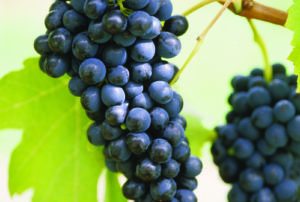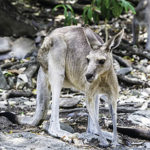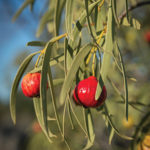Australia
by Ruth Tobias
IN SOME WAYS, THE STORY of cuisine in Australia is strikingly similar to our own. It starts with aboriginal peoples living off a land of plenty; it continues with British colonists largely rejecting those native resources in favor of importing their own. And its latest chapter unfolds as a rediscovery of the homegrown bounty on the one hand, a celebration of vibrant multiculturalism on the other.

Of course, Australia’s indigenous foodways—locally known as bush tucker—are markedly different than those of America. Kangaroo, emu, barramundi (sea bass), marron (a type of crayfish), and witchetty grubs count among its most distinctive fauna, while notable flora include quandong fruit, wild plums, the wattleseeds of the acacia, karkalla (a succulent with a saline character), and lemon myrtle; all have become increasingly visible on Australia’s contemporary dining scene. At the same time, many of its most iconic foods have foreign origins, from U.K.-style meat pies and hamburgers topped with beets to the salt-and-pepper squid introduced by Chinese immigrants and the pork roll, a variation on Vietnamese bánh mì. (Notable exception: Vegemite, the infamous bread spread made from yeast extract, was indeed invented Down Under.)
Its modern wine industry is also foreign-rooted: After all, Australia has no native grapes. But the varieties it has adopted have certainly proven to thrive here. First and foremost, of course, is Shiraz, no less prized in the Barossa Valley than it is in the Rhône. The Cabernet Sauvignon of Margaret River and Coonawarra is world-renowned as well. And Pinot Noir from cooler-climate regions like Mornington Peninsula and Tasmania has made its own splash in recent years. By the same token, the Riesling grown in, say, the Eden and Clare Valleys is steadily finding its footing among Australia’s more-established white wines—including the Sémillon that goes into many of its acclaimed dessert wines and the Chardonnay that winemakers in Tasmania are increasingly using in much-buzzed-about sparklers. The latter are still hard to come by stateside, but as the thirst for bubbly spreads worldwide, that may change soon enough.
What Does Bush Tucker Taste Like?
As in the U.S., so in Australia are today’s chefs developing a newfound appreciation for aboriginal ingredients. Here are a few you might encounter in the modern kitchens of Sydney and Melbourne as easily as on the Outback.

Kangaroo: Often compared to venison in flavor, the meat of the kangaroo is on the milder end of the gaminess spectrum. Its leanness means it can toughen quickly, so it’s generally cooked no more than medium-rare; it can even be served raw in the form of tartare.

Emu: Though a fowl species, emu’s actually considered a red meat, with a lower fat content but a flavor profile similar to beef, which indicates how it’s often prepared: in the form of steaks, burgers, sausages, even jerky.

Wattleseed: Acacia seeds are said to have a nutty character with hints of coffee and chocolate; they’re often roasted, ground into flour, and used for baking or seasoning.

Quandong: Sometimes nicknamed “desert peach,” this bright-red fruit bears some similarityto better-known stone fruits, though it generally falls on the tarter side of sweet. It’s typically used to make pastry filling and jam.
